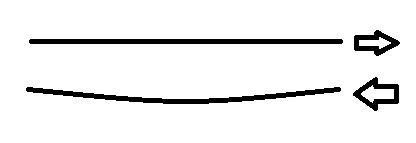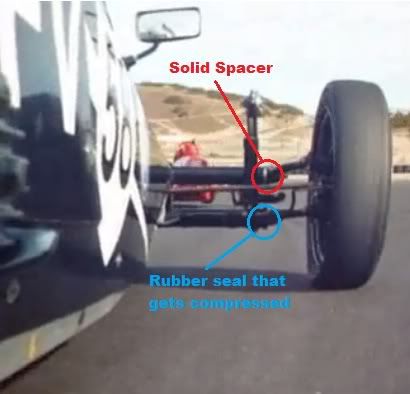
Link Pin Beams - Bottom Trailing Arm Flexing (not Bending)
sander288 - May 27th, 2011 at 04:56 PM
http://www.youtube.com/watch?v=dombJDMiOc0&feature=related
If you view this video it shows the bottom trailing arm bending on the link pin beam; which is why whenever you see a L/P beam put under pressure they
go way positive on the outside around a corner. This is on a vee so the loads arn't huge, it would be worse on a bug I would imagine.
What do others reckon why this happens on a Link Pin car?
I've talked this over a bit with Greg Mackie and he suggested it must bend because on the B/J cars they beefed the trailing arms right up...
Interested in others thoughts.
Cheers
Shaun
vwo60 - May 27th, 2011 at 08:13 PM
I studied the video and it is very difficult to determine what is actualy flexing, the tyre is all over the place and possibly the rim, the stub axle
will also flex along with both trailing arms, i have a link pin car with 17" rims and it handles very well, i think it's a combination of things,
all types of suspension will flex and probaly the ball joint front end would not be to far behind it, i drive my car quite hard and have never bent a
trailing arm, so it must be stong enough to handle the increased load's without bending anything
chequer57 - May 27th, 2011 at 08:21 PM
In Vees if they put a tonne of static negative into a link Pin front end it will bind, most they can get away with is about 1-2 degrees (playing with
shims). If they run it loose enough to not to bind, the slop will give positive camber anyway.
The wheel bearing in Vees are run on the loose side too to cut down on rolling resistance that adds to load induced camber change.
I wouldn't say the Vee in the vid's set up is that tight also he is running the anti roll bar in the top tube. So pic of the effect of doing that
below.

and

Most guys in NSW Vees run the anti roll bar in the bottom as the thought is they'd rather pull on the leaf spring in the top and have the solid
spacer in the bottom.
In Vees they run standard everything no bent beams (US and Oz) or special stub axles and on each side one of there is a rubber between the
arms and the beam.
Vees also they don't run any anti roll at the rear so all the body roll is picked up at the front and it the front of the car tilts that equals the
camber on the wheels (nature of the trailing arm suspension).
Vees also apply a lot of lateral loads as they have a low centre of gravity, they don't have the deal with the body roll throwing the car off the
road.
With a ball joint beam you don't have the binding issue you dial in the amount of neg camber and it works.
Hope that helps answer your question.
Regards,
Ian
HappyDaze - May 28th, 2011 at 08:24 AM
After more than 50 years of 'mucking about with VWs, I KNOW THE LOWER FRONT TRAILING ARMS FLEX ['bending' is probably not the right term,Shaun].
The struts that I have fitted to each of my front lower trailing arms has proved this.
sander288 - May 28th, 2011 at 08:20 PM
yeah my bad, bending implies permanent damage; flex is right.
It didn't seem to be as bad on my car this time out though; due to new bearings (matching now!! I took out outside rollers and on the inside it had
ball bearings on it!!!) but also there is less leverage from the wheel because of the small vee tyres.
I've got some photos of your car greg from the sprint and it appears to have a little more lean with the bigger tyres than it used to but I think its
just the tyre roll
Ian, thanks for the diagrams and screenshot; speaking of front negative camber have you ever heard of cars with bent stub axles to achieve more
camber?
Cheers
Shaun
chequer57 - May 28th, 2011 at 08:29 PM
Umm have a look at a few photo of the smiling H-Beams the Vees in NZ (known as Formula First) run.,
http://www.formulafirst.co.nz



PS: Greg is right about flexing and I forgot to add that in the spring pack in a Vee there is anywhere between 3 & 2 halfs to 5 leaves in the pack
(not the shandard 4 and 4 halfs) that why we get flex.
HappyDaze - May 29th, 2011 at 08:15 AM
Shaun,
You're right about the body roll - I put it down to the extra 70 kg of roll cage, high up. Maybe that's why it's called a 'Roll cage'? This will
give me something to think about. The extra weight has certainly
slowed the car down a bit.
The extra weight has certainly
slowed the car down a bit.
Ian,
The rubber seals on the trailing arms should NEVER have any load on them. If the tapered 'grub' screws are tight, there should be no 'side-ways'
movement. In the case of the anti-roll bar, the 'side-ways' movement is taken up by spacers, which DO HAVE load on them, as there is no centre
retainer on the anti-roll bar.
The 'smiling beam' will give some static negative camber, unlike the Porsche RSK, which has a 'V' shaped TOP tube only. Some say that is where the
'K' is from in the RSK, because the beam looks like a 'K' on its side. This means that the outside wheel will 'go negative' on cornering.
There's lots to think about, but it's all good fun.
Cheers,
Greg
chequer57 - May 29th, 2011 at 12:37 PM
Hi Greg,
When running a reduced spring pack in the beam the the rotten this bows and flexs even if clamped, centre and end (clamp a single
leaf in a vice an push from one end you'll see what I mean). The spring also gets shorter when twisted, the joys of metals. More of a reason it
make sense to run the spring pack in the top of a H-Beam in Formula Vees.
I reckon lesson is; if you can, run solid spacers to and bottom between arms and beams.
PS: Love the the term K Beam ..... very cute






 The extra weight has certainly
slowed the car down a bit.
The extra weight has certainly
slowed the car down a bit.
